|
Gotheborg.com is the largest resource of information on all aspects of collecting antique Chinese and Japanese pottery and porcelain on the Internet. To help pay for the costs necessary to distribute the content of this site to our visitors, donations towards the running of Gotheborg.com are highly appreciated.
We hope to make a difference in how antique Chinese and Japanese porcelain is perceived and collected, by making accessible a wealth of specialized knowledge that is not possible to find elsewhere, and by continuously addressing the evolving production of fakes that are appearing in the market place in ever greater numbers. Fakes not only causes a loss to the collector in financial terms but even worse, distort and diminish the historical heritage the genuine pieces provide.
I think that in some manner we have done well so far and would like to express my gratitude for your participation and support.
Jan-Erik Nilsson
Gotheborg.com
The Meridian Gate;
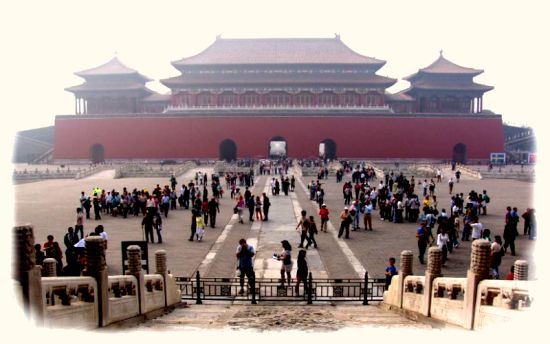
The South and most prestigious Gate into the Imperial Palace was the huge front gate, the Meridian Gate or Wumen, where only the Emperor himself was allowed to pass through the central one of the five portals. The entire palace is organized along a central north-south (meridian) axis, which goes clear through the middle of these five portals of the gate. When coming back into the Palace, after having performed any of the important sacrificial ceremonies at any of the huge altars outside the Palace, the Emperors way was then through this mid portal, continuing over the central of five bridges and then being carried over a huge marble rock in the foreground of this picture, with carved dragons. This mid part of the staircase lacks steps, so that no evil spirits could follow him. This route would eventually lead to the three big halls that make up the main part of the Outer Court. These three halls are the Hall of Supreme Harmony, the Hall of Central Harmony and the Hall of Preserved Harmony. These halls would be where the Emperor received high officials, accepted tribute and conducted the administration of the empire. Seen from above these three halls are organized as three jade discs on a string seen from the side, making up the Chinese character wang as in 'emperor'.
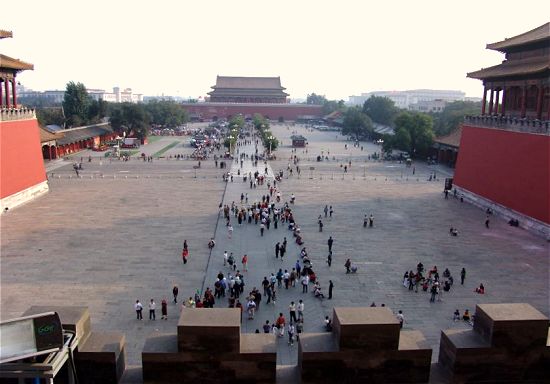
Standing on the balcony of the huge pavilion on the top of the Wumen, still facing out and further South, this would be the exact spot where the Emperor stood when celebrations of victory, ceremonies to accept prisoners of war and announcements of new calendars, took place on the courtyard down outside. On each side of the gate there are two large wings, on top of which there are two pavilions. In the east one (left), drums were installed that were beaten when the Emperor went to perform sacrifices at the Temple of the Ancestors. In the west pavilion (right) there were bells, who were rung when the emperor went to the Temple of Heaven. In the far distance still further south is the outer Tiananmen, 'Gate of Heavenly Peace' and outside of that, the Tiananmen Square. To the left in the far distance today is the the National Museum, to the right, the National Congress building and hidden behind the gate itself - also symbolically placed on this central axis, is the Mausoleum of former Chairman Mao.
Today 'Meridian Gate' is the name of the highest sponsor's rank at the Gotheborg.com Discussion Board followed by the 'Gate of Divine Might', the Shenwumen and the 'Western Glorious Gate', or Ximen. The 'East Glorious Gate' or Donghuamen, are for sponsors who participate though monthly subscriptions.
Meridian Gate Level Sponsors
Gate of Divine Might;
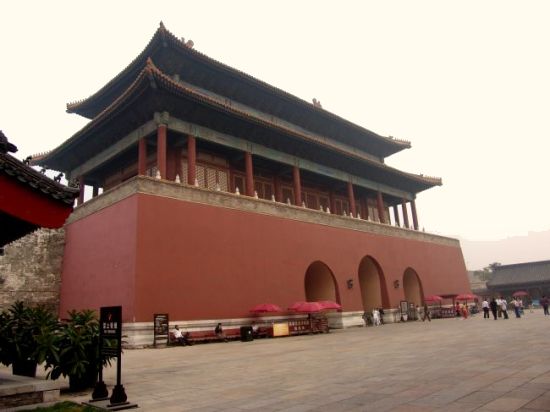
In the northern part of the Forbidden City and behind the Outer Court lies the Inner Court where the Emperor and his family had their personal quarters. The scale of things are more human if one might say so. The pavilions and gardens are mostly one or two storeys and the private quarters of the Imperial family are modest, as far as Emperors goes. In many ways it feels like you could move right in. The studio where the Qianlong Emperor sat and discussed art and literature with the foremost intellectuals of his time feels nice and comfy. The area consists mainly of the Palace of Celestial Purity, the Palace of Terrestrial Tranquility, the Hall of Celestial and Terrestrial Union, six courtyards to the east and six to the west.
The Gate of Divine Might shen wu men connects the Inner Court directly with the market area to the north of the palace.
Gate of Divine Might Sponsors
West Glorious Gate
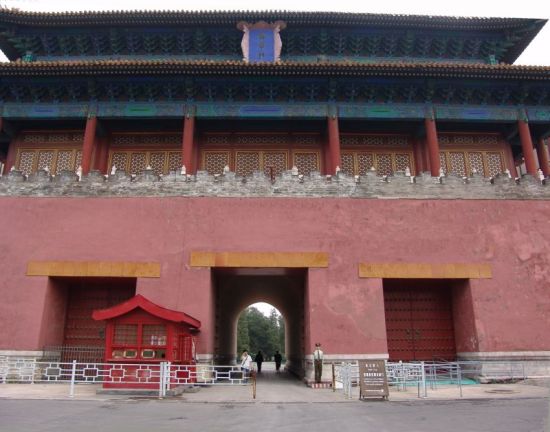
The Ximen or the West Glorious Gate is considerably less grand than the South and the North. On the other hand this was the everyday practical entrance for the entire staff working on the west side of the palace ground, since nobody were allowed to cross the central line through the palace but the Emperor and possibly the family and the highest of the officials. This was also the entrance through which the Imperial family members used when going to the Summer Palace for grand celebrations or for entertainment.
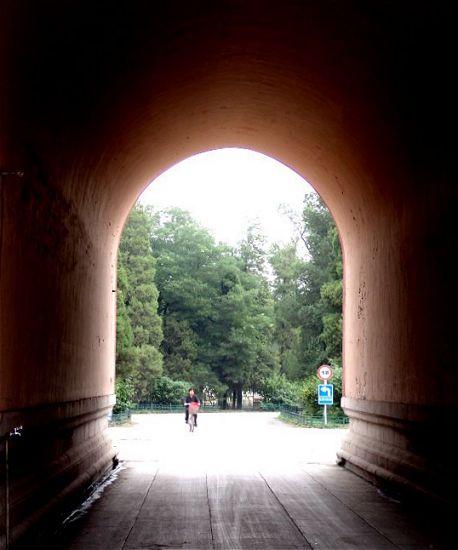
Close inside of the entrance portal in the West Glorious Gate.
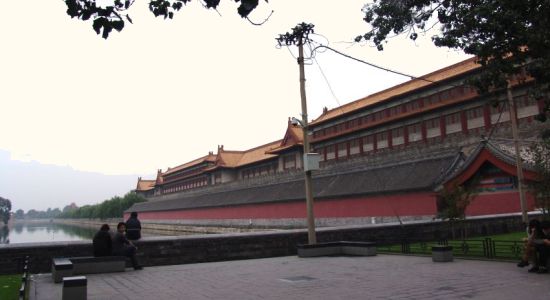
As you perceive it when approaching the Imperial Palace, this would be the left side of the Forbidden City. The actual Western Gate is located along the western (left) side of the Palace, closer to the main entrance at the South side of the Palace than to the North Divine Might entrance. When looking like this along the moat towards north, the northwestern corner watchtower is barely visible in the far distance. In the background you can see the partly man made Coal Hill, where the last emperor of the Ming Dynasty hung himself when all was lost for his dynasty.
East Glorious Gate

First time I actually came to the Forbidden City in a car, it was through this gate. For those who have not entered here, it is not exactly just a gate and then you are 'inside' something, well, in a way you are, but the Palace Grounds are so large that when you enter here you actually comes into a small suburb with large trees and garden areas and with numerous small and large pavilions. It just continues and continues and it takes quite a while before you recognize where you are and enter what you recognize as the palace grounds, just inside the Wumen Gate.
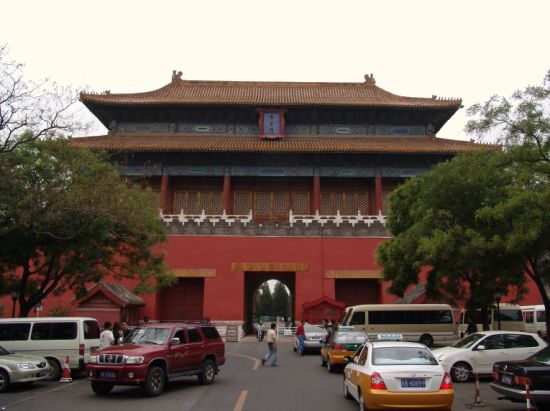
It is hard to tell how this could have looked a few hundred years ago but in reality the Palace ground was a working place and quite a lot of areas was set aside for stockpiling and workshops for building upkeep, as it is today, and also the production of all kinds of necessities for the city inside the walls. It is easy to feel that this, including the work of administrating a huge empire, was going on inside this gate.
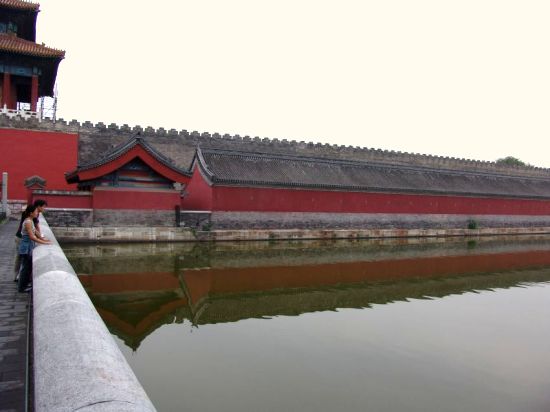
East Glorious Gate - Donghuamen - and its bridge over the palace moat, the couple at the rail are looking towards north.
East Glorious Gate Sponsors
The Gotheborg web page went online first time in 26th of November 1996 under the by Jan-Erik Nilsson registered domain gotheborg3.se, to focus mostly on the Swedish East India Trade to China during the 18th century. In 1996 it changed name and focus towards a Chinese and Japanese Porcelain Collectors Help and Information page. The 27th of June 1999 an email list was added. In April 23, 2003 the discussions were moved into a private Discussion Board to avoid spam and guarantee continuity. Over the years many people have joined this collectors community, made friends, had fun and on the whole contributed to make the world a little better place. Design and content of all pages as they appear on gotheborg.com © Jan-Erik Nilsson, Gothenburg, Sweden 1993-2017.
|
